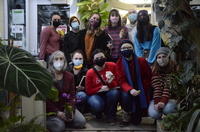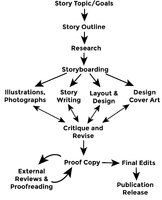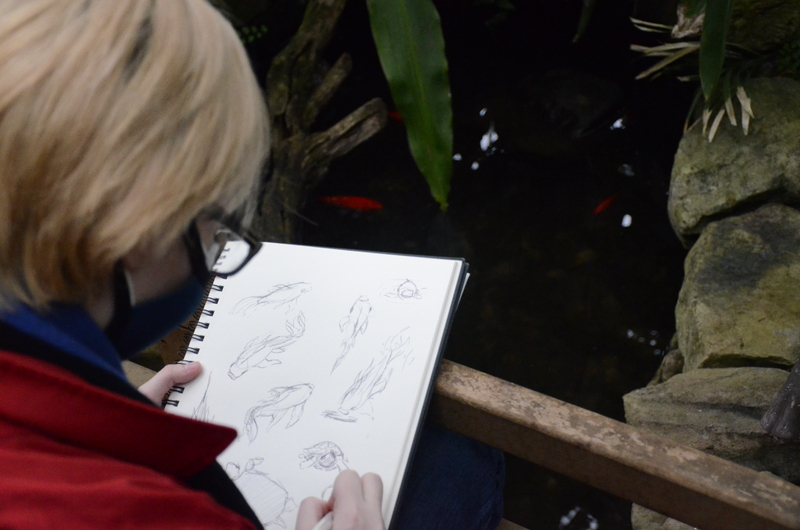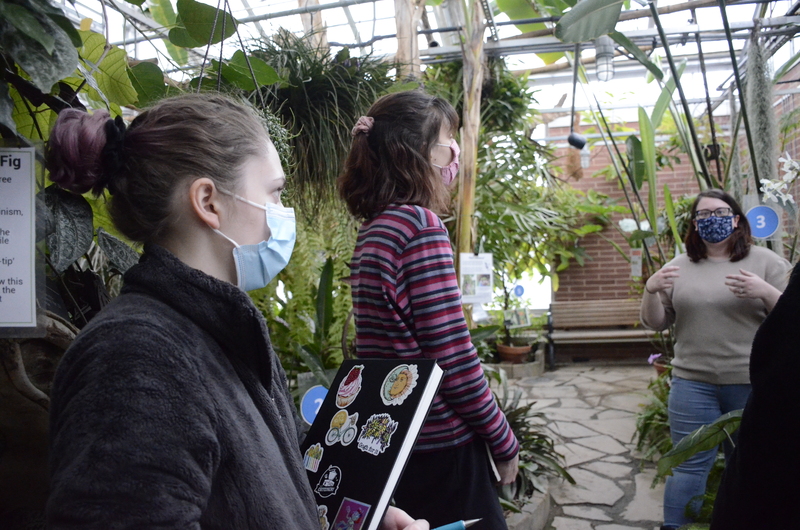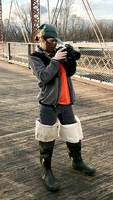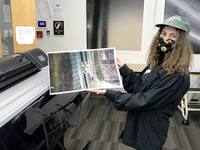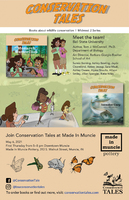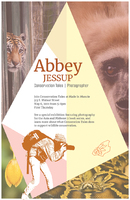Our Process
The Conservation Tales project has developed a process for a team of students to develop books in a single semester. This page shows key elements in the process.
Each book is created by a team of students including illustrators, science writers, photographers and graphic designers. The process and team structure was developed as the project grew from a single illustrator to the plan you will see in this exhibit.
As the project grew, innovative ideas were suggested by students, and project finally reached its current structure in 2019. As part of the dissemination of the project, the faculty advisors published an article that includes the figure shown here that explains the process used to develop the books. (McConnell, T. J. & Giorgio-Booher, B. (2020). Collaborative Teams for Self-Publishing: A model for creating locally-relevant educational books. Global Journal of Transformative Education, 2, 33-45.)
The following information is organized to reflect the process shown in the figure.
As you read, click the images to see larger versions!
Research
Each Conservation Team begins with researching the topic. This entails communicating with scientists who study the featured species, interviewing them, observing them at work, and meeting the animals and their habitats. When possible, the team travels to visit scientists in the field.
COVID precautions made travel difficult in 2021, so the team focused on researchers at Ball State. Travel included local visits to sites with habitats, meetings with scientists, and two trips to the Indianapolis Zoo. The books developed will add to a previous "Midwest Series" that features species and scientists found here in Indiana.
During the trips, team members sketch animals and habitats, people, and relevant scenery. The team also collects photographs and interviews the researchers. While Zoom meetings and emails are useful for gathering information, the authenticity of the books is enhanced greatly when students meet the scientists in their workplaces, and gain a deeper understanding the scientists and their research in a real-world context.
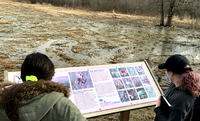
Monarch Butterfly team visits a local prairie park near the White River.
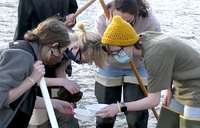
The Invasive Carp team learns first hand about the aquatic invertebrates that are threatened by invasive fish species by sampling the White River.
The research also helps the team understand the animals and habitats featured in the books.
This research gives the Conservation Tales books a level of authenticity that is rare in children's books about wildlife. The animals are drawn as accurately as possible for the books, without anthropomorphizing them. Children, teachers, parents and scientists have all reported that the combination of photographs and illustrations in the Conservation Tales books helps readers recognize that the stories we tell are based on REAL science, REAL animals, and REAL problems.
By combining authentic images and stories that show what scientists do, the team is able convey two important messages in the books:
"Everyone can protect wildlife!"
"Anyone can be a scientist!"
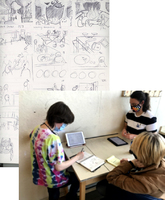
Team members meet to create storyboards.
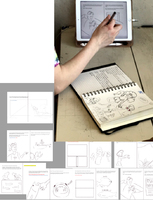
Team members create sketches and convert them to PDF to integrate text.
Storyboarding
Another early step is to develop an outline of the story and a storyboard. Team members decide who the characters will be, including the diversity characterists we include in each book. They work with Dr. McConnell to build a story framework, then the team develops intial storyboards. This skill is standard practice in animation and digital story telling.
The storyboards are also a first chance to plan the images for the book and lay out a plan to integrate text. Artists, photographers and graphic designers meet to create the storyboard. They then meet each class meeting to revise the storyboard as they start work on the illustrations and design work.
At the same time, the co-authors flesh out the story text, writing dialog, and analyzing to make sure the text is at an appropriate reading level for grades 3-5.
Sketchbooks
Click the images to see the larger version
As they research and observe the animals, scientists and scenery, team members use sketchbooks to make intial drawings, develop illustrations and take notes.
In the classroom meetings, the team shares the sketches, and discuss ideas for illustrations and stories based on the images.
All team members are provide materials to create sketches. Each artist picks the medium they use to illustrate the book, and the team then collaborates to ensure that images use similar color palettes and styles.
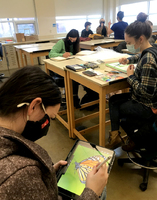
Working in the studio to develop content.
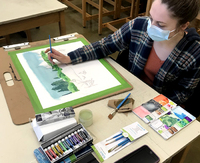
Allison uses gouache paints for the Monarch book.
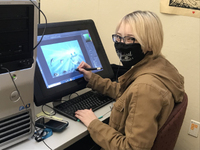
Illustrator Ashley Bowling works with digital painting tools to create images for the Invasive Carp book.
Book Production Process
Research and observation leads to production work. The team uses the contents of sketchbooks and journals to write the story, draw and paint illustrations, collect and edit photographs, and create page layouts for the books, promotional materails, and educational resources.
Team members choose the media in which they create illustrations, and the project provides media, paper and tools for the artists. The team uses class time to work on images, including studying other examples of illustration styles, specimens and models in the classroom, and resources from content consultants.
Some illustrators create images using digital painting tools. The team uses animation labs in the School of Art, tablets and laptops to sketch, outline and paint the media.
The teams create samples, then save scan or photograph the images. Graphic designers then combine the images in Photoshop to see if the styles blend well. Digital tools can also help add features like shadows, ripples in water, and other accents that make the combination of multiple images look seamless to the reader.
As the teams create text and images, they share works in progress during critique sessions. This is a typical practice in art courses, but for non-artists on the team, this is a new process.
In the critiques, everyone in the course can ask questions, suggest changes to images or ways to improve illustrations, and help shape final decisions to improve the overall quality of the product.
This collaborative project often generates creative ideas for the stories, including connections to previous books, "Easter eggs" that the team places in the layouts, and revising to ensure we accurately depict what we learned from the scientists.
Photographs are also used in the book. Abbey Jessup is the team's photographer, and she takes photos for the book. She sorts and edits images, chooses the best quality images for the book, and helps organize the files for the graphic designers. Other team members also sometimes contribute photos for the project.
In most books, we also find we need to use images from the scientists, and photos from third-party sources. Any images from outside the team must be credited to the source, and Abbey's job includes documenting the sources, and any permissions or licenses needed in order to use the photos.The project uses public domain and Creative Commons sources when needed, so documenting this information and creating a "Photo Credits" page for the book and the website.
Abbey also documents the team's activities. Images or the collections of books, our site visits, and classroom activities are used for social media, websites, promotional materials, and presentations.
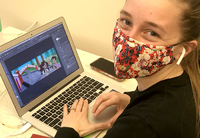
Graphic designer Alyssa Shoults compiles the elements into a final page layout.
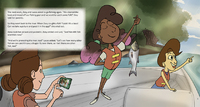
Sample of a "spread"
Design and Layout
Graphic designers from the Visual Communications program then compile artwork, text, and photographs into the final book layouts. The designer contributes to the planning of the book from the very start, and then combine all the content of the books into a final format.
The designers use industry-standard software, and base the designs on a style guide created by a previous member of the team to ensure continuity through the multi-year study. Experienced members of team teach younger members the process to help provide experience across multiple years.
Graphic designers also help create a "series logo" for each year's team using the primary logo and images of the animals featured in the books. The logo is used for t-shirts, name badges we wear for site visits, and posters. The designers also develop posters, graphics for social media and the website, and educational materails.
Outreach and Engagement
The Conservation Tales team also shares what they have learned and the educational materials that accompany the books for outreach and engagement with the community.
While COVID precautions have restricted this engagement for the last year, the team will present an exhibit at the May 2021 First Thursday event. See the promotional photo at the right created by Graphic Designer Sarah Misak.
Sarah has also produced a poster about the diversity of CT characters as a way to convey the message that "Anyone can be a scientist." This poster will be used for future events.
Previous cohorts took part in First Thursday events, community garden fairs and craft shows, after-school reading programs at local schools, and learning and art activities at local venues like the Ross Community Center, Minnetrista, and Nature Play Days. The team was also invited to exhibit artwork and host a Community Day event at the Midwest Museum of Natural History in Sycamore, IL. To date, Conservation Tales team members have been part of 29 different community outreach and engagement events.
